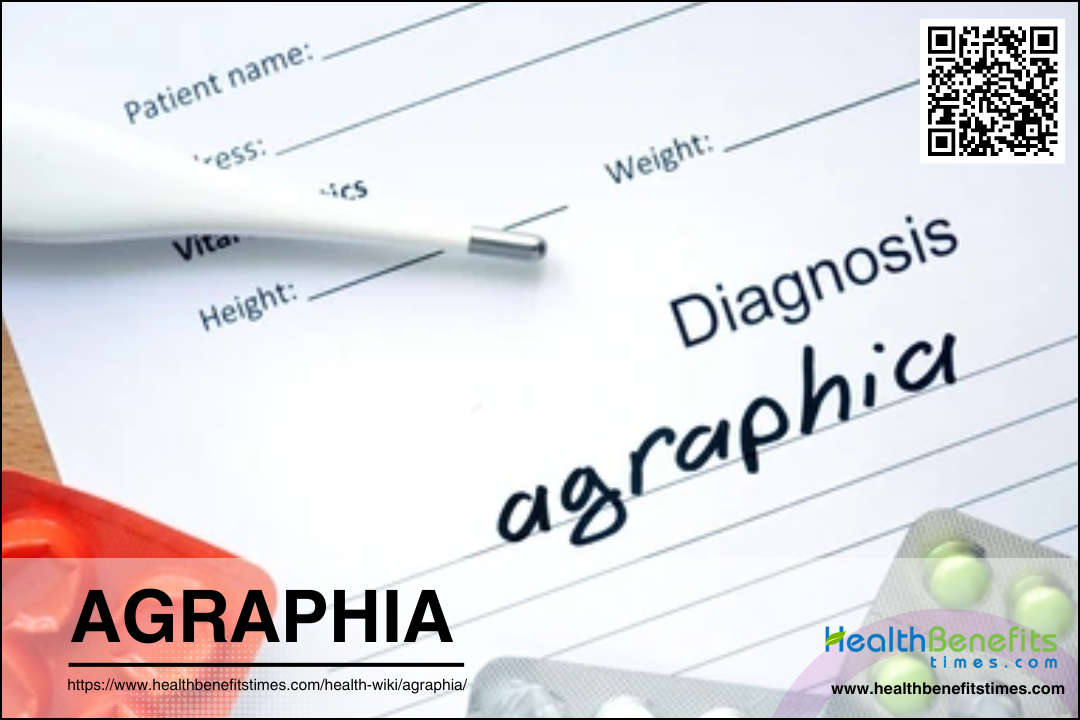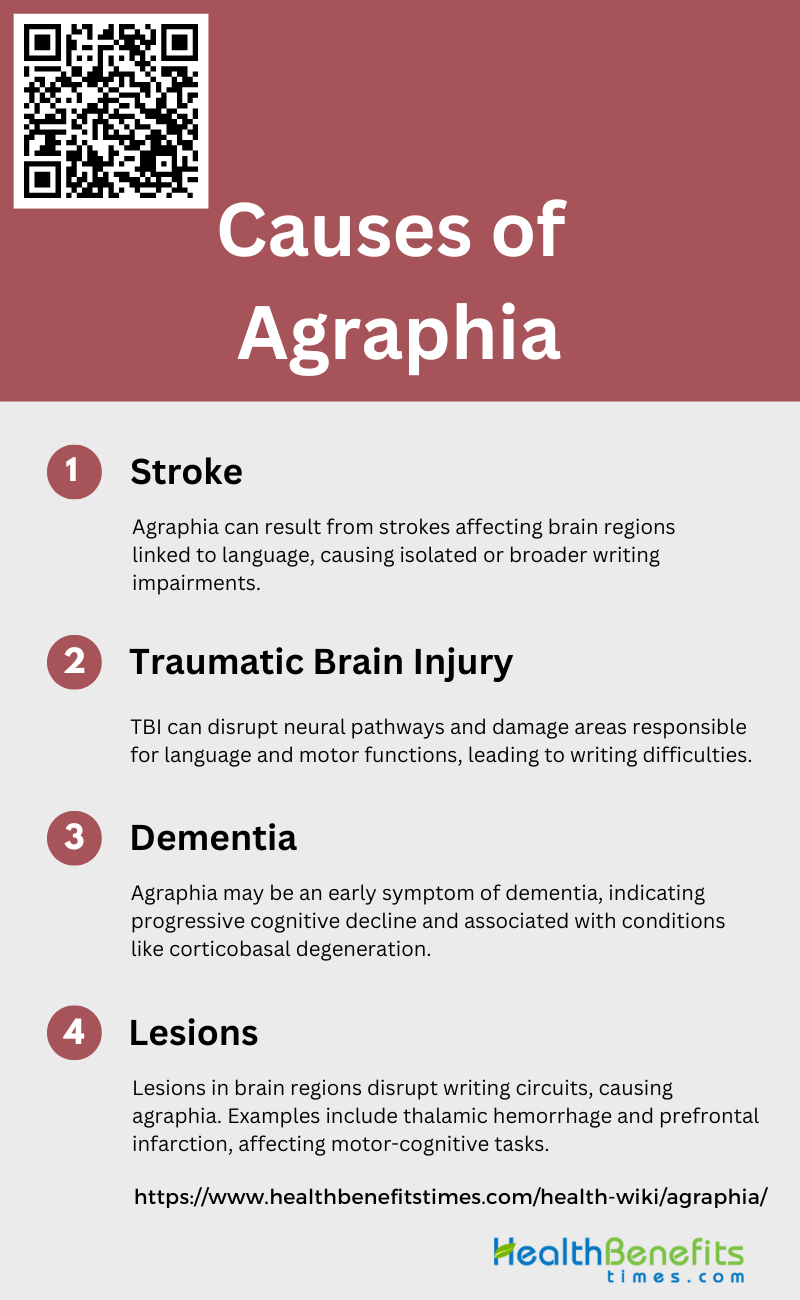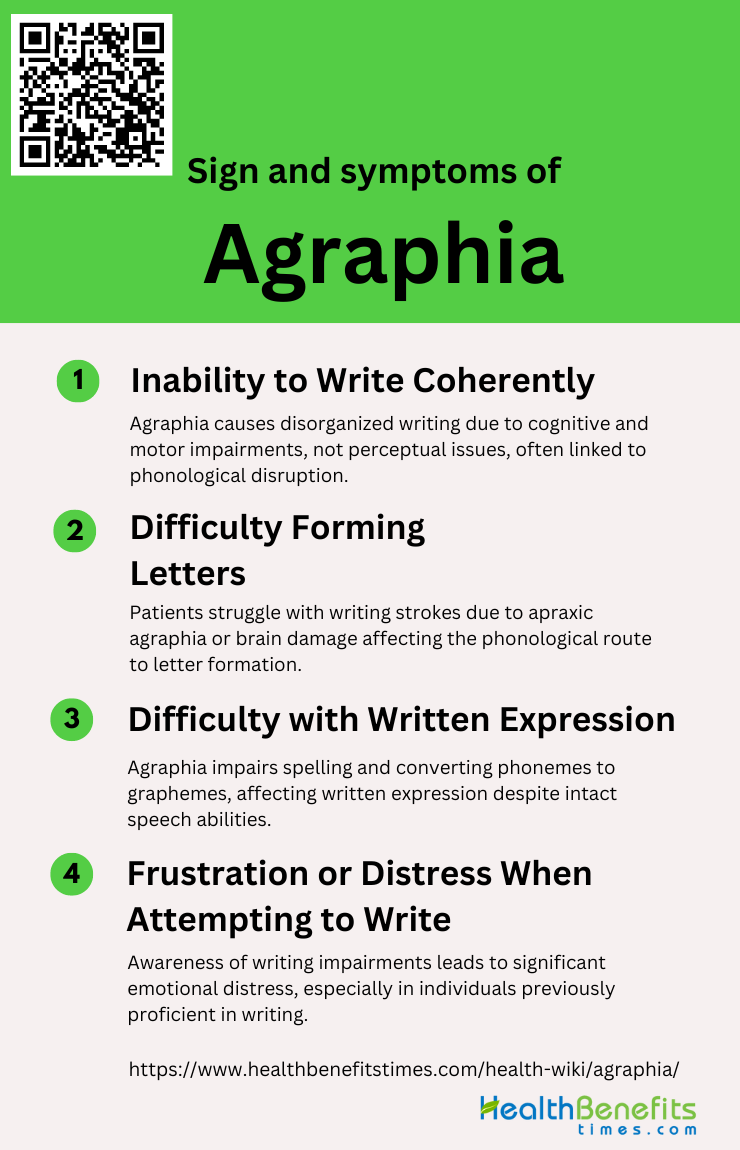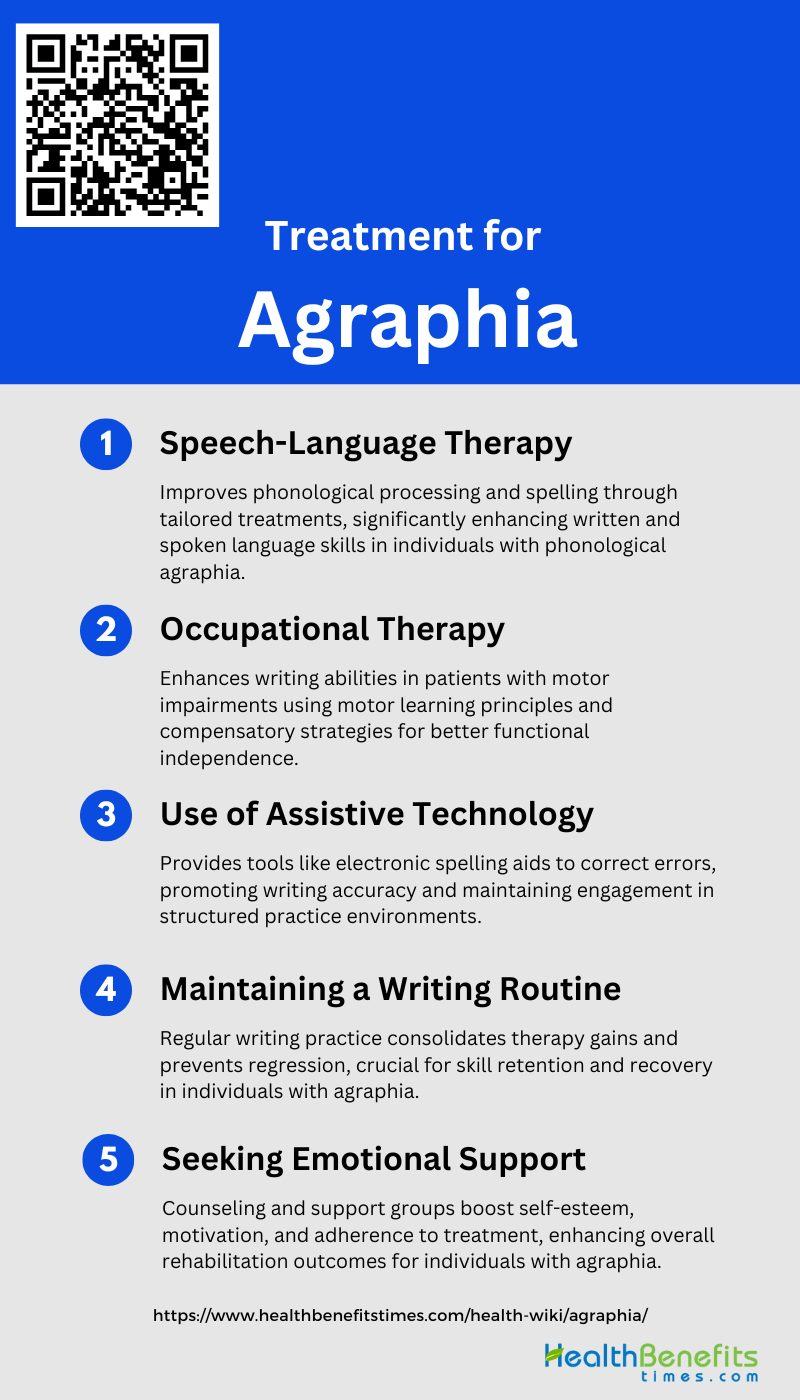 Agraphia is a neurological disorder characterized by an impairment or loss of the ability to write, caused by brain dysfunction or damage. It is an acquired condition, meaning that the individual previously had the ability to write, but lost it due to brain injury or disease. Agraphia can occur in isolation, but it is often accompanied by other language deficits such as aphasia (impaired ability to speak or understand spoken language), alexia (impaired ability to read), or apraxia (impaired ability to perform purposeful movements). The specific symptoms and severity of agraphia can vary depending on the location and extent of the brain lesion, ranging from mild difficulties with spelling or handwriting to a complete inability to produce written language.
Agraphia is a neurological disorder characterized by an impairment or loss of the ability to write, caused by brain dysfunction or damage. It is an acquired condition, meaning that the individual previously had the ability to write, but lost it due to brain injury or disease. Agraphia can occur in isolation, but it is often accompanied by other language deficits such as aphasia (impaired ability to speak or understand spoken language), alexia (impaired ability to read), or apraxia (impaired ability to perform purposeful movements). The specific symptoms and severity of agraphia can vary depending on the location and extent of the brain lesion, ranging from mild difficulties with spelling or handwriting to a complete inability to produce written language.
Types of Agraphia
Below, we explore two different types of agraphia that individuals may experience.
1. Central Agraphia
Central agraphia, also known as linguistic or aphasic agraphia, involves impairments in the language processing components of writing. This type of agraphia affects the ability to spell and construct grammatically correct sentences. It is often associated with damage to the language-dominant hemisphere of the brain, particularly areas involved in phonological processing and lexical retrieval. Individuals with central agraphia may produce frequent spelling errors, substitute incorrect words, or write sentences that lack proper syntax. This condition can occur alongside other language deficits such as aphasia and alexia, making comprehensive language assessment crucial for accurate diagnosis and treatment.
2. Peripheral Agraphia
Peripheral agraphia, also known as nonlinguistic or non-aphasic agraphia, is characterized by difficulties in the motor aspects of writing. This type of agraphia involves impairments in the physical act of writing, such as forming letters and maintaining proper spacing and alignment on the page. It can result from damage to various parts of the brain, including the parietal, frontal, or occipital lobes, and may manifest as apraxic agraphia, visuospatial agraphia, or motor nonapraxic agraphia. Individuals with peripheral agraphia may retain the ability to spell and understand language but struggle with the mechanical execution of writing, often producing illegible or poorly organized text.
Causes of Agraphia
From neurological damage to learning disabilities, the triggers are as complex as the brain’s pathways for language and writing. Here, we delve into the primary factors that can lead to the development of agraphia.
1. Stroke
Agraphia, the inability to write, can be a direct consequence of a stroke, particularly when it affects specific regions of the brain involved in language processing. For instance, a case study reported a 62-year-old man who developed pure agraphia following a left temporal lobe stroke. This isolated writing disturbance persisted until a subsequent cerebrovascular accident led to total aphasia and right hemiplegia. Another study described a patient with pure agraphia after a deep left hemisphere hematoma, which prevented linguistic and graphemic systems from accessing the frontal motor program. These cases highlight that localized damage to language areas due to stroke can result in agraphia.
2. Traumatic Brain Injury
Traumatic brain injury (TBI) can also lead to agraphia, although specific cases in the provided data are not detailed. However, it is well-documented in the literature that TBI can cause various cognitive and motor deficits, including those affecting writing abilities. The disruption of neural pathways and damage to brain regions responsible for language and motor functions can result in difficulties with writing. The extent and nature of agraphia following TBI would depend on the severity and location of the injury.
3. Dementia
In a study investigating three patients with progressive agraphia, it was found that difficulties in writing, particularly with Kanji (Japanese morphograms), were among the initial symptoms. These patients later exhibited other cognitive impairments, suggesting that agraphia may precede more widespread cognitive decline associated with conditions like corticobasal degeneration. Additionally, stroke patients are more prone to developing dementia, which can further exacerbate writing difficulties due to the combined effects of vascular lesions, white matter changes, and potential Alzheimer pathology.
4. Lesions
Lesions in specific brain regions can cause agraphia by disrupting the neural circuits involved in writing. For example, a case of agraphia following a left thalamic hemorrhage was reported, where decreased blood flow in the left thalamus and associated cortical areas was observed. Another study described a patient with agraphia and acalculia due to a left prefrontal infarction, highlighting the role of the prefrontal cortex in writing and arithmetic processes. These examples illustrate that lesions, whether due to hemorrhage, infarction, or other causes, can impair the brain’s ability to coordinate the complex motor and cognitive tasks required for writing.
Sign and symptoms of Agraphia
Below is a list of common signs and symptoms associated with this condition.
1. Inability to Write Coherently
Patients may struggle with the correct motor sequences for writing, leading to disorganized and incoherent text. This difficulty is not due to perceptual or memory problems but rather a disruption in the phonological or lexical routes used for writing. Additionally, progressive agraphia can be an early sign of degenerative dementia, further complicating coherent writing as cognitive functions decline.
2. Difficulty Forming Letters
Difficulty in forming letters is a common symptom of agraphia, particularly in cases of apraxic agraphia. Patients may have trouble with the physical act of writing, such as sequencing writing strokes correctly, even though they can verbally state the correct sequences. This issue can arise from damage to specific brain regions, such as the left superior parietal lobule, which is crucial for the execution of writing. Similarly, disruptions in the phonological route can lead to difficulties in letter formation, as the conversion from phonemes to graphemes is impaired.
3. Difficulty with Written Expression
Patients with agraphia often experience significant difficulty with written expression, which can manifest as impaired spelling and the inability to convert phonemes to graphemes. This impairment can occur even when other language functions, such as speech, remain intact. The difficulty in written expression can also be linked to degraded knowledge about spelling and the correspondences between sounds and letters, affecting the overall ability to express thoughts in writing.
4. Frustration or Distress When Attempting to Write
The frustration or distress experienced by individuals with agraphia when attempting to write is a notable symptom. This emotional response is often due to the awareness of their impaired writing abilities and the effort required to produce written text. The inability to write coherently or form letters correctly can lead to significant emotional distress, especially in individuals who were previously proficient in writing. The progressive nature of some forms of agraphia, such as those associated with degenerative dementia, can exacerbate these feelings as the condition worsens over time.
Diagnosis of Agraphia
Diagnosing this condition involves a comprehensive evaluation of the individual’s writing skills, cognitive abilities, and neurological status. Below is a list of criteria and assessments used in the diagnosis of agraphia.
1. Sensory and Nerve Function Tests
Sensory and nerve function tests are crucial in diagnosing agraphia, as they help rule out peripheral nerve damage or motor neuron disease as potential causes. For instance, in a case study of a 55-year-old man with motor neuron disease, sensory and motor nerve conduction velocities were normal, indicating that his agraphia was not due to peripheral nerve dysfunction but rather central nervous system involvement. Similarly, another study highlighted that sensory action potentials were normal in patients with agraphia, suggesting that the condition is more likely related to central rather than peripheral nervous system issues.
2. Cognitive and Memory Tests
Cognitive and memory tests are essential for diagnosing agraphia, as they help identify associated cognitive impairments. For example, neuropsychological testing in patients with progressive agraphia revealed impairments in verbal language, executive function, visuospatial cognition, and memory, indicating that agraphia often coexists with other cognitive deficits. Additionally, in Alzheimer’s disease, agraphia was found to be associated with disturbances in multiple cognitive domains, including visuoperceptual impairment, language, praxis, and attention. These tests are vital for understanding the broader cognitive context in which agraphia occurs.
3. Diagnostic and Imaging Tests
Diagnostic and imaging tests, such as MRI and CT scans, are instrumental in identifying the underlying neurological causes of agraphia. For instance, MRI scans in patients with agraphia have shown atrophy in the bilateral temporal regions of the brain, suggesting a link between temporal lobe degeneration and writing impairments. Similarly, CT and MRI scans have identified cerebral infarctions in the left parietal lobe as a cause of agraphia, highlighting the importance of imaging in pinpointing specific brain regions involved. These imaging techniques provide critical insights into the structural and functional abnormalities associated with agraphia.
Treatment for Agraphia
Rehabilitation strategies often involve a multidisciplinary approach, combining cognitive therapy with specific writing exercises. Below is a list of interventions commonly employed in the treatment of agraphia:
1. Speech-Language Therapy
Speech-language therapy is a cornerstone in the treatment of agraphia, particularly for individuals with phonological agraphia. This therapy focuses on strengthening phonological processing and the connections between phonology and orthography. For instance, a study demonstrated that a two-stage treatment protocol significantly improved phonological processing abilities and spelling performance in individuals with phonological agraphia. Another study highlighted the effectiveness of concurrent reading and spelling treatments, which resulted in significant improvements in both written and spoken language for a patient with moderate aphasia. These findings underscore the importance of tailored speech-language therapy in addressing the specific deficits associated with agraphia.
2. Occupational Therapy
Occupational therapy plays a crucial role in the rehabilitation of individuals with agraphia, particularly those with motor impairments affecting writing. For example, patients with apraxic agraphia, characterized by poor letter formation due to difficulties in programming skilled movements, benefit from treatment approaches based on the principles of motor learning. A case study demonstrated that applying these principles led to significant improvements in writing legibility for a patient with apraxic agraphia. Additionally, occupational therapy can help patients develop compensatory strategies and adaptive techniques to facilitate writing, thereby enhancing their overall functional independence.
3. Use of Assistive Technology
Assistive technology offers valuable support for individuals with agraphia by providing tools that compensate for writing difficulties. Electronic spelling aids, for instance, have been shown to help patients detect and correct spelling errors, thereby improving their overall writing accuracy. Moreover, the use of technology can facilitate the practice of writing skills in a structured and supportive environment, promoting greater engagement and motivation. The integration of assistive technology into treatment plans can thus enhance the effectiveness of rehabilitation efforts and support the maintenance of writing skills over time.
4. Maintaining a Writing Routine
Maintaining a consistent writing routine is essential for individuals with agraphia to reinforce learned skills and promote recovery. Regular practice helps to consolidate improvements achieved through therapy and prevents regression. For example, a study on the recovery process of a Japanese alexic without agraphia emphasized the importance of consistent practice in reading and writing, which led to significant improvements in the patient’s abilities. Establishing a daily writing routine, whether through structured exercises or practical writing tasks, can help individuals with agraphia maintain and enhance their writing skills.
5. Seeking Emotional Support
Emotional support is a critical component of the treatment for agraphia, as the condition can significantly impact an individual’s self-esteem and quality of life. Engaging with support groups, counseling, and therapy can provide individuals with the emotional resilience needed to cope with the challenges of agraphia. Emotional support can also enhance motivation and adherence to treatment plans, thereby improving overall outcomes. The psychological well-being of patients should be considered an integral part of the rehabilitation process, as it can significantly influence the effectiveness of other therapeutic interventions.
Prevention of Agraphia
Preventing agraphia involves proactive measures to safeguard neural pathways associated with writing and language. By maintaining brain health through regular mental exercises and managing risk factors for neurological disorders, individuals can reduce their chances of developing this condition. Here are several key strategies to consider for the prevention of agraphia:
1. Eat a balanced diet and maintain a healthy weight
Maintaining a balanced diet and a healthy weight is crucial for overall brain health and can help prevent conditions that may lead to agraphia. A balanced diet rich in essential nutrients supports cognitive functions and reduces the risk of stroke, which is a common cause of agraphia. For instance, a stroke in the left posterior cerebral artery can lead to conditions like alexia without agraphia, highlighting the importance of vascular health in preventing such neurological deficits. Therefore, a diet that supports cardiovascular health can indirectly help in preventing agraphia.
2. Don’t ignore infections
Infections, particularly those affecting the brain, can lead to severe complications including agraphia. For example, cyclosporine toxicity, which can occur during recovery from organ transplants, has been associated with transient neurologic syndromes including agraphia. Ignoring infections or not managing them properly can lead to complications that affect brain regions responsible for writing and other cognitive functions. Therefore, timely treatment of infections is essential to prevent potential neurological damage that could result in agraphia.
3. Wear safety equipment
Wearing safety equipment is essential to prevent head injuries that can lead to agraphia. Traumatic brain injuries can cause hematomas or other damage to brain regions involved in writing. For instance, a hematoma in the left centrum semiovale can result in pure agraphia by disrupting the connection between linguistic and motor systems. Using appropriate safety gear, such as helmets during high-risk activities, can significantly reduce the risk of such injuries and the subsequent development of agraphia.
4. Manage your health conditions
Proper management of chronic health conditions is vital in preventing agraphia. Conditions like hypertension, diabetes, and cardiovascular diseases increase the risk of strokes, which can lead to agraphia. For example, a stroke in the left posterior cerebral artery can cause alexia without agraphia, a condition closely related to agraphia. Regular monitoring and management of these health conditions can help prevent strokes and other complications that may impair writing abilities. Therefore, maintaining good health practices and adhering to medical advice is crucial in preventing agraphia.




